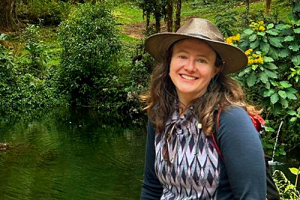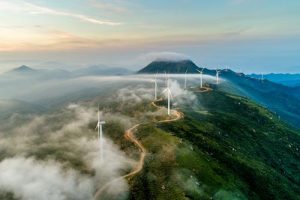Empowering Environmental Leaders in a Changing World
Published February 13, 2024

To address pressing issues like climate change, habitat loss, water scarcity, air pollution, and species extinction, the next generation of environmental leaders will need a deep understanding of the science behind the problems, the technologies that may help solve them, and the nuances of policymaking.
Empowering such leaders for pivotal roles in the public and private sectors is JHU’s MS in Environmental Sciences and Policy program, led by Program Director Cassandra Hansen, who also leads JHU’s MS in Geographic Information Systems program. Hansen took the helm in early 2023 and brings to the job extensive knowledge of geosciences, GIS, and environmental policy, as well as a strong desire to equip students with the expertise and resources they need to forge their path in the field.
Read on for insight from Hansen about her role at JHU, how the Environmental Sciences and Policy program helps students pursue their goals, and more.

What is your role in the programs you lead?
As the program director for ESP and GIS, I oversee over 40 adjunct instructors and 450 students. I am lucky to have a talented team to help me, including Geri Miller, Associate Program Director in GIS, and Program Coordinators Rachel Isaacs and Lama Elhatow.
I also teach in the ESP and GIS programs. For the ESP program, I teach one of our core courses, Oceanic and Atmospheric Processes, and an elective, Air Quality and Policy. And I teach a handful of field courses. For the GIS program, I teach Cartography and Data Visualization every fall and Emergency Management every summer.
How does your background influence your work as program director and as an instructor?
I think the range of jobs that I have held over the years has provided me with an interesting perspective for students. From working with the federal government doing land surveying up in Alaska, to working as a backcountry emergency responder for the National Park Service, as well as holding roles in many different environmental nonprofits along the way, I’ve had the opportunity to see environmental science in the real world and also environmental policy as it’s going through the different branches of government and organizations. I have also spent much of my professional life as an environmental GIS consultant, and I find that GIS is an important tool for all Environmental Sciences and Policy students.
As an instructor, I draw on that experience and share it with my students, and as program director, it has helped me ensure that we are offering the best field experiences and courses that reflect our changing world.
What is the goal of the ESP program overall and in terms of preparing students for work in this field?
The goal is to ensure students understand environmental science and policy, with current, cutting-edge information and exposure to technology and data collection, and policymaking procedures. We also want to ensure students understand the connection between science and policy. Science drives policy, so understanding how data is collected and understanding the needs of the scientists goes hand-in-hand for our future policymakers.
We have students who come right from four-year colleges and institutions with undergraduate degrees, and students who are in the industry and either looking to make a pivot or hoping to move up in their branches. So, we address all their needs. Whether environmental science and policy is brand new to them or they are already working in the field, we can ensure they’re getting the most out of our program and are prepared to go in whatever direction they choose.
Who are the students who pursue the ESP program?
Many of our students are actively holding internships or full-time positions in various government sectors. For example, they are working in the White House, EPA, Department of Defense, or Department of Interior. They may be looking to move on to supervisor or manager positions, and they want a more well-rounded exposure so that as they go into these leadership roles, they understand all the different pieces of environmental science and how that fits into policy.
Other students just want to get their foot in the door in environmental science and policy because their background is in a different field. What’s wonderful is that the seasoned students who are in the industry provide so much value to students who want to get a start. Our instructors provide mentorship, of course, but we also see a type of parallel mentorship among students that happens, where students will meet each other in the program and start talking about what they do and their background. And then they help each other. Those linear connections are such an important part of the student experience.
And who are the instructors that make up the ESP faculty?
Our instructors are amazing. First, they are all highly accomplished professionals working in environmental science or making policy decisions. They are out there collecting the data and encouraging policy and community engagement. They are talking to their students one-on-one about what they are doing and getting students involved with projects that they are working on. They are having conversations with students about current events and policy changes in our government.
How do you and the program help students pursue an area of focus if they choose to?
It is an interdisciplinary program, and we offer courses in a wide range of topics, so the path a student takes through the program will depend on what the student is seeking to do. For example, if a student knows they want to focus on conservation biology, or environmental justice and equality, or even climate change and energy policy, we provide recommendations for courses they should take. But we have students who are in the program, and there are so many interesting topics to choose from that they are not sure if they want to have a specific focus area. They want to expose themselves to a wide range of environmental science courses, and they can do that, too. And sometimes students do not have a focus in mind until they take that one course that captivates them—maybe it is international law, or environmental policy, or environmental ethics—and they have an “aha” moment where they think, “This is my path.” It’s always exciting to see that.
How do you use field courses to support learning?
We have a residency requirement for our program, and our field courses satisfy that requirement, although students also have other options, like an onsite or weekend course. But our field courses are unique. We take students all around the world, and it is an opportunity for students to meet the cohorts they have been participating with online, to meet the professionals in the field, and to see real-world problems firsthand.
Students can take a field course whenever they would like, but often we find that they take it later in their degree so that the courses they have been taking and the knowledge they have gained come together. It is a nice culmination of the degree itself.
Do you have a favorite place you’ve taken students?
Yes, for a field course I teach, The Intersection of Science and Society, we take students to Southern Oregon and Northern California along the Klamath River. It is not as glamorous as going to the Galapagos, but it is one of the largest environmental restoration projects in our country and it is happening right now, which presents some exciting opportunities. There are four large hydrological dams that are no longer useful and are being taken down. Students see the dams, learn about why they are no longer useful, and how they impact water quality, among other things. They can meet with the folks who have been working for 30 years to get these dams removed, and they gain an understanding of some of the many different organizations involved—most importantly, the four tribes that came together and in alignment were able to work with state and federal government agencies and nonprofits. So just being able to bring the students to this location and experience it, that is what makes it one of my favorite field courses.
How does technology affect what students are learning today and in the future?
Geographic Information Systems is an area of technology already being used for environmental projects, and we expect its use to continue growing. There are many uses, but I’ll give one example. One of our new field courses is called the Blue Economy, and it focuses on living shoreline restoration and aquaculture, which can have a harmful impact if not done properly but can be beneficial if done well. In this course, students create GIS apps and use drones to collect all sorts of base data—such as water turbidity—for the area they are studying. And they can see the data in real time on a map. That’s where, as a student, you’re thinking, “O.K., now it’s all coming together.” Everything they have learned in their courses they can now apply in the field and then communicate that data as well.
What is going on in the world that affects the way you and your faculty prepare students for their future roles?
One of the foundational trends is the increasing importance of science communication and being able to speak the language of science to a broad audience. It is vital to have the ability to interpret what is happening on the scientific side of things and to communicate it. Helping students develop that ability will always be part of this program, and it is a challenge, but it is needed. Another trend is that society is now actually saying the words “climate change,” and demonstrating the ability to focus on climate change, which makes communication so important.
Finally, a topic that is at the forefront and will continue to be is water. Not everyone has drinking water readily available, and climate change will continue to impact water as a resource. So, understanding the challenge, the laws related to water, and the possible solutions will continue to be extremely important in the years to come.
Interested in pursuing a graduate degree at Johns Hopkins University? Request information to learn more or apply here.